Implications of Changing Population Dynamics for Bangladesh Development Strategy
By
The 1994 Cairo Conference on Population and Development (ICPD) laid down broad principles and a framework for measuring progress with population management and its use for promoting development. When measured against that framework, Bangladesh performs well in having made progress on the population front. Total fertility rate (TFR) climbed down from a high of 6.9 in 1974 to 2.1 in 2018; population growth rate fell from 3.5% to 1.2%; infant mortality rate decelerated from 130 per thousand live birth to 22; maternal mortality fell from 750 per one hundred thousand live births to 179; and life expectancy increased from 46 years to 72.3.
This progress was achieved on the basis of empowering women and families to make family size choices. Public policy support focused on providing reproductive health facilities and knowledge; investment in girl’s education; and investment in health care. A strong partnership with the donor community and the NGOs allowed low-cost delivery of basic reproductive and healthcare services to the door step of the rural communities.
The progress of Bangladesh in population management compares favorably internationally (Table 1). This performance exceeds the results achieved for the average performance in the developing countries and the average performance in South Asia. The results in reducing TFR and increasing life expectancy are particularly good. The progress in empowering female through education and access to credit based on the micro-credit revolution is also admirable.
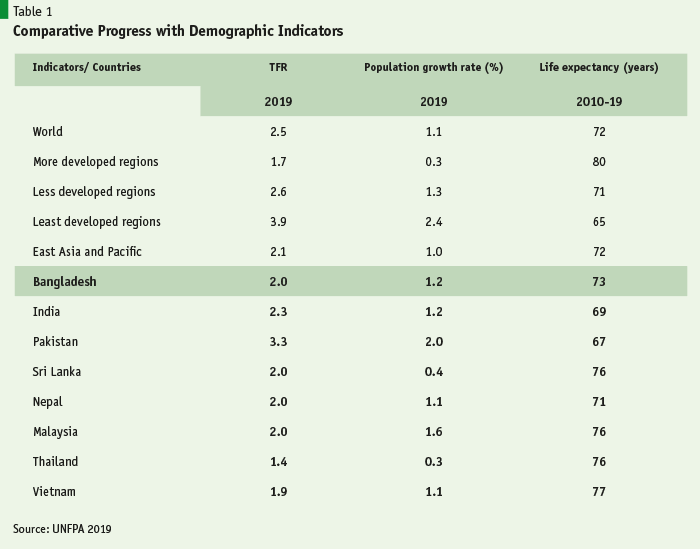
The strong performance on the population front has been converted positively in securing overall progress with national development. The changing population dynamics sharply lowered the dependency ratio and increased the labor force supply at a much faster pace than the growth of population owing to the demographic dividend. Combined with progress with education, the low-cost and abundant labor was a major contributor to the acceleration of the GDP growth rate, especially through the production and exports of ready-made garments (RMG). A significant share of the growing labor force found its way into the labor-short, oil-rich countries of the Middle East and contributed to the rapid expansion of export earnings and income flows to the mostly low-income and poor rural and urban families. Remittances not only contributed directly to support the consumption of the poor and low-income families, they also supported the growth in income and employment opportunities in a large number of rural industrial and service enterprises, especially construction, trade and transport.
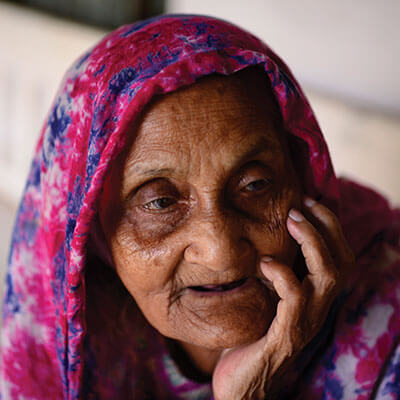
The rapid growth in GDP and remittances along with reduction in the population growth rate accelerated the expansion of per capita gross national income that crossed the threshold of the World Bank -defined low-middle- income country (LMIC) in 2015. Per capita income in 2019 was estimated at $1909 and with 8% GDP growth rate, Bangladesh was amongst the fastest growing country in the world. The rapid progress with human development along with rising income contributed handsomely to the reduction in poverty. The incidence of moderate poverty was estimated at 24.3% in 2016 as compared with 77% in 1974. The incidence of extreme poverty declined to 14.9% in 2016 as compared with 41% in 1983. Armed with this strong development success, the government now aspires to achieve Upper Middle-Income Country (UMIC) status in FY2031 and High-Income-Country (HIC) status in FY2041.
Notwithstanding the strong performance on the population front, there are many challenges that remain.
First, despite legally mandated ban on child marriage, there is still substantial child marriage (below 18 for girls) that contributes to a high adolescent fertility rate. The incidence of child marriage is among the highest in the world and adolescent fertility rate is the highest in South Asia
- First, despite legally mandated ban on child marriage, there is still substantial child marriage (below 18 for girls) that contributes to a high adolescent fertility rate. The incidence of child marriage is among the highest in the world and adolescent fertility rate is the highest in South Asia (Table 2).
- Second, the adoption of modern contraceptive practices is still low relative to Asian countries and there is uneven progress across districts, rural, urban income and age groups (Table 3).
- Third, the incidence of maternal mortality is still too high and needs to come down substantially further (Table 3).
- Fourth, at only 50%, the attendance of skilled staff during birth is amongst the lowest in the world and needs quick resolution (Table 3).
- Fifth, despite progress with female empowerment, the large incidence of gender-based violence (GBV) remains a serious threat to the progress with the female empowerment agenda.
- Sixth, even though the female labor force participation rate has increased, at 36%, it is on the low side.
- Seventh, the unemployment rate for the youth (age 15-29) is very high (10.6%). A large part of the unemployed youth is educated. Additionally, there is a substantial youth group (28.2% of the youth population) that is neither in employment, nor in education or in training (NEET). These suggest that the full benefits of the demographic dividend are not being used. They also suggest that there are major issues with the quality of education and training.
- Eighth, the gender gap in tertiary education and vocational training remains substantial, which needs to be addressed comprehensively.
- Ninth, the demographic changes are causing a rising share of the elderly population. In Bangladesh this is defined as the 60 plus population, although internationally the definition uses 65 plus. Whichever way the elderly population is defined, the size is growing. This poses major challenges for old-age pension support and geriatric health care and Bangladesh is not well-prepared for either of the two challenges.
There are major challenges on the development front as well. First and foremost, the growth of employment has slowed considerably. Second, there is evidence of growing income inequality owing to the absence of a redistribute fiscal policies. The rich do not pay their fair share of taxes while public spending on health, education and social protection are too low and inadequately targeted to the poor. Third, a major problem facing Bangladesh is the severity of the fiscal constraint. As a result, public spending on health is a mere 0.7% of GDP, on education it is around 2% of GDP and 1.2% of GDP on social protection excluding civil service pensions. These are amongst the lowest spending in middle income countries and will not be adequate to address satisfactorily the population, education, health care and social protection needs of Bangladesh.
…public spending on health is a mere 0.7% of GDP, on education it is around 2% of GDP and 1.2% of GDP on social protection excluding civil service pensions. These are amongst the lowest spending in middle income countries and will not be adequate to address satisfactorily the population, education, health care and social protection needs of Bangladesh.
Finally, the growth of labor force, structural change in production in favor of industries and services and climate change induced vulnerabilities in agriculture have induced a major shift of population away from rural areas to urban areas. The associated urban transition has been unplanned and concentrated heavily on Dhaka. It is recognized that urbanization and development are interlinked and urbanization is inevitable as development proceeds. Yet, this pattern of growing and concentrated unplanned urbanization has created tremendous development challenges in terms of traffic congestion, shortages of housing and other basic urban services and growing urban environmental degradation, especially in terms of air and water pollution. The absence of proper institutional arrangements has constrained the capacity of urban entities to supply the required services. The chaotic urbanization poses a major threat to sustaining the upward GDP growth momentum.
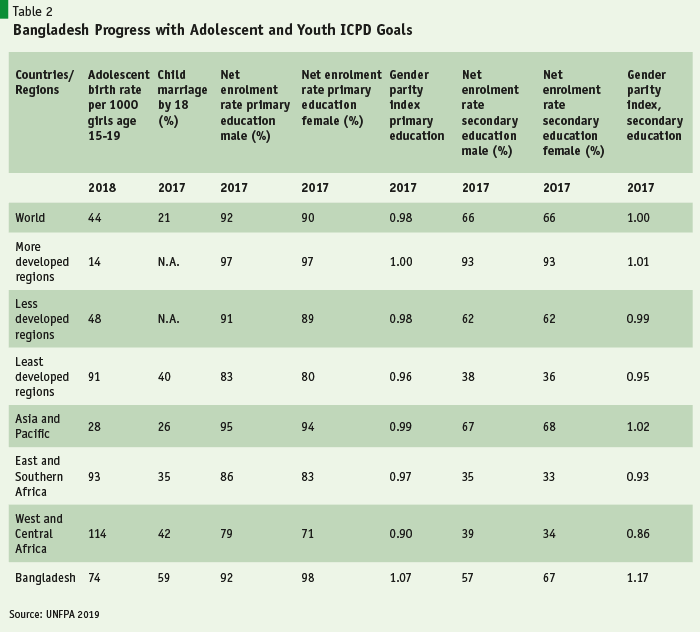
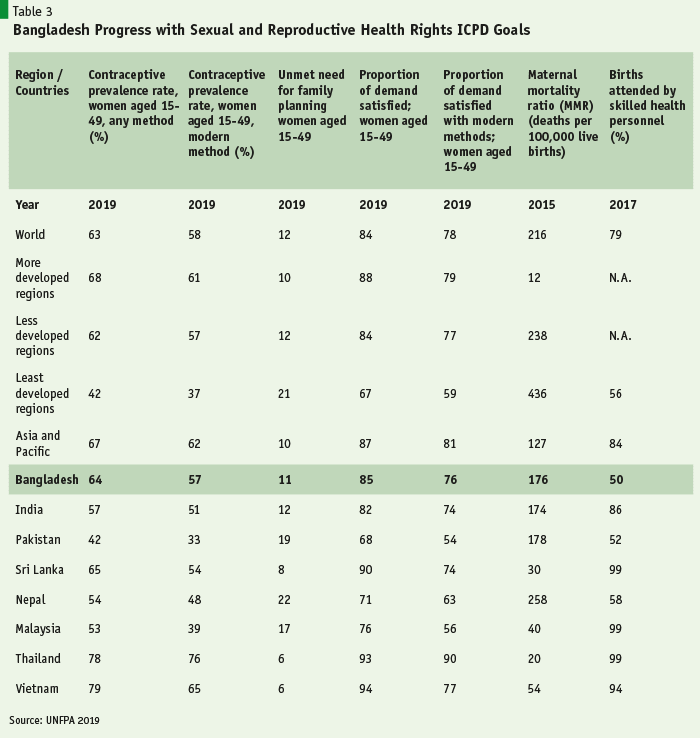
Against the backdrop of the above-mentioned issues, the population dynamics is changing. Total population will continue to grow over the next 30 years, adding to the already high population density, which will challenge development owing to the further pressure on the land resource and the natural environment. The projected pattern of population suggests that total labor force will continue to grow faster than population, presenting a policy challenge to create more jobs and reverse the down-turn observed recently in national job creation. The youth employment challenge will grow further, and the old age problem will get more acute. The proportion of adolescent girls will also grow making it that much more important to address the child marriage and adolescent pregnancy issues more boldly and with a concerted effort. The urbanization projections suggest a further rapid growth in urbanization, which, unless managed well, would accentuate the already difficult urbanization challenge.
The projected pattern of population suggests that total labor force will continue to grow faster than population, presenting a policy challenge to create more jobs and reverse the down-turn observed recently in national job creation. The youth employment challenge will grow further, and the old age problem will get more acute.
The agenda moving forward is indeed enormous and substantial policy reforms are necessary. The government has formulated the Perspective Plan 2041 (PP2041) to define its development objectives, targets, strategies and broad policy framework for next two decades. The Eighth Five Year Plan (FY2021-FY2025) (8th FYP) is the first plan aimed at implementing the PP2041 strategy. It is expected that the 8th FYP will incorporate the changing population dynamics and the associated population management agenda in defining the national and sectoral development strategies and policies for FY2021-FY2025.
The policy reforms related to population management and the associated implications for development for the 8th FYP can be summarised as follows:
• Strengthen the outreach and campaign on sexual education and reproductive health issues to increase the adoption of modern contraceptive practices with special attention to the lagging districts, the rural poor, the urban slums and the adolescent girls. The rural health clinics need to be adequately staffed and equipped to meet the demand for modern contraceptive devices and counselling. Partnership with NGO-based community health workers should be strengthened to reach out the women in the urban slums and to provide services to rural women at the door step.
• Strengthen the implementation of the law against child marriage with support from local government agencies, education staff, NGO-based health and social workers, the community leaders and the religious leaders. The full legal provisions should be enforced against violating families. Education campaign against child marriage should be enhanced through use of national TVs and the print media.
• Enhance the capacity to increase the percentage of births attended by trained staff from 50% to 75% by the end of the 8th FYP by increasing resources and staffing in the rural health clinics and the district level hospitals.
• Strengthen the implementation of the National Women’s Development Policy (NWDP) 2011 to enhance the pace of progress in empowering women and eliminating all gender-based inequalities. The government should develop a results-based monitoring and evaluation (M&E) framework with quantifiable targets to measure progress with NWDP 2011 implementation on an annual cycle. These targets can be developed in consultation with the national researchers, NGOs active in the field and the donor community.
• Undertake a comprehensive study on estimating the economic cost of GBV focusing on direct, indirect and induced economic costs for both public and private sectors. The study should also provide a holistic strategy and policy framework for addressing GBV drawing on good practice international examples. Bangladesh may formulate strategies in line with the ‘whole system’ that focuses on all three important aspects: prevention, provision and protection. This is a high-priority agenda for the 8th FYP.
• Further increase efforts to increase girls’ enrolment in secondary, TVET and tertiary education. Policy actions should include establishing girl’s secondary schools, TVET institutions and colleges in lagging regions; ensuring that each education facility has security and girls’ toilet facilities, ICT education and supplies, lab equipment and supplies, and trained teachers; and special scholarships for girls.
• The ongoing demographic transition will continue to support a faster growth of labor force than the population growth. In addition to continuing with efforts to further increase the rate of growth of GDP, the recent slowdown in the growth of employment must be arrested by increasing efforts to increase the employment elasticity of GDP growth. Important policies include spurring the growth of RMG by reversing the sharp appreciation of the real exchange rate and reducing the cost and improving the quality of infrastructure and trade logistic services; sharply lowering trade protection to reduce the anti-export bias of trade policies and promote export diversification; and promote the growth of a dynamic micro and small enterprise (MSE) sector through improved access to institutional credit and other supportive measures.
• The female labor force participation has stagnated at around 36% and is considerably lower than the rate found in East Asian economies. The government should seek to increase female labor force participation rate to around 64% by FY2041 as found in South Korea. For the 8th FYP, the corresponding target should be about 43%. The policies noted above relating to education, training and female empowerment including actions against GBV should help. Additionally, to enable labor force participation of young mothers, efforts should be made to increase the supply of low-cost day care facilities. This could be done in collaboration with private enterprises and NGOs.
• The youth employment challenge will increase progressively as demographic changes continue. This requires urgent policy attention to ensure that the demographic dividend is not wasted. A detailed review and policy analysis of the youth employment challenge have been done in December 2019 based on the request from ILO (Ahmed and Sattar 2019). The main policy recommendations relevant to the 8th FYP include: strengthen education quality through sharp increases in public spending on education and training; enter into formal partnerships with private sector, donors and NGOs in increasing the job relevance of training; promote the spread of ICT by reducing high taxation; promote self-employment of youth through entrepreneurship based on training and access to institutional credit; and support international migration in districts that are not benefitting from this facility through training, finance and information.
The youth employment challenge will increase progressively as demographic changes continue. This requires urgent policy attention to ensure that the demographic dividend is not wasted.
• The rapidly growing aging population needs strong policy attention. It requires policies to support the income of the old-age population and policies to support their healthcare and physical well-being needs. Bangladesh has an Old Age Allowance (OAA) program that is poorly targeted and misses out most of the poor and vulnerable population. The monthly allowance is also well below the poverty income level. The changing population dynamics will sharply increase the size of the aging population and will challenge the already strained fiscal capacity. On the health care front, Bangladesh does not have the readiness to address the growing needs of the old -age population. Among the reforms needed during the 8th FYP include: consider redefining the old age for retirement and pensions purposes from 60 plus years to 65 plus years as per international convention; implement the Old Age Program as defined under the NSSS 2015; consider implementing a universal old age pension scheme based on a combination of public and private funding and partly voluntary; consider moving towards an universal health care (UHC) system that uses a mix of publicly and privately funded health insurance and low-cost public health care facilities.
• Growing income inequality is a major social concern in Bangladesh. The experience of Western Europe shows this can be best addressed by implementing a redistributive fiscal policy that combines a system of progressive income taxation with substantial spending on healthcare, education and social protection. In Bangladesh, despite strong commitment to human development and poverty reduction, public spending in health is a mere 0.7% of GDP, it is 2.0% of GDP in education and 1.2% of GDP on social protection (excluding civil service pensions). These levels of spending are much lower than those found in East Asian economies and yawningly lower than those found in Western Europe. For the 8th Plan, the minimum spending targets by the end of the plan period should be: 1.5% of GDP on healthcare; 3.5% of GDP on education and 3% of GDP on social protection (excluding civil service pensions).
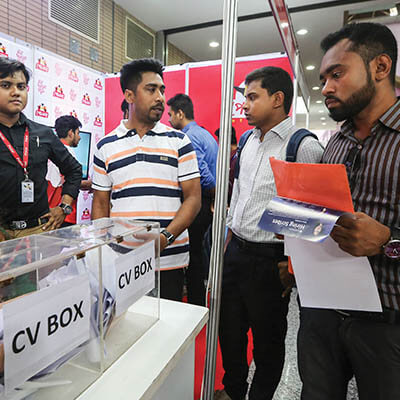
• Additionally, the implementation of the NSSS has to be substantially strengthened. The NSSS was approved in 2015. After 4 years, progress has been very slow. The proper consolidation of the large number of small schemes into the proposed life-cycle framework has not happened. There are major problems with targeting with all schemes that have to be fixed. A well-worth result that should be monitored under the development results framework (DRF) of the 8th FYP is the completion of the implementation of the NSSS.
• Possibly the most complex challenge is to substantially increase the tax revenue base. At around 9% of GDP, the tax revenue is not only one of the lowest in the world it has also been falling over the last two years. This is a serious constraint on development and could jeopardize the implementation of the PP2041. Accordingly, the PP2041 has adopted a comprehensive fiscal reform package that seeks to increase the tax to GDP ratio to 17% by FY2031. Converting this to the context of the 8th FYP, this amounts to increasing the tax/GDP ratio to 14% by FY2025. The full implementation of the PP2041 fiscal plan would be the most fundamental development challenge for the 8th FYP.
Possibly the most complex challenge is to substantially increase the tax revenue base. At around 9% of GDP, the tax revenue is not only one of the lowest in the world it has also been falling over the last two years. This is a serious constraint on development and could jeopardize the implementation of the PP2041.
• Finally, the changing population dynamics will further increase the urbanization momentum. Given the growing problems with unplanned urbanization, the government has developed a comprehensive urbanization strategy in the context of the PP2041. The strategy calls for a change in urban governance and fiscal management. The proposed reforms include: (a) Legally mandate a clear division of service delivery responsibilities between national and local governments with no over-lapping responsibilities. (b) establish an accountable city government that is elected by the residents, has full administrative responsibilities for delivery of all services legally assigned to the city governments, and is fully accountable to its residents and not the national government. (c) establish a legally mandated system of fiscal autonomy that assigns a specific share of national revenues based on well-defined criteria including population share and poverty incidence and some specific taxation authority, especially the property tax. The city governments will receive the government transfers as block grants and will have full flexibility to design and collect the property tax. The city governments will also recover cost from service deliveries where feasible. (d) The national government will encourage the growth of the left-behind divisional cities noted above through special grants and nationally funded projects to better equip these cities to provide essential urban services. Two particularly important initiative would be to establish Water and Sewerage Authority (WASA) and Urban Mass Transit Authority in all of the eight divisional cities along with provision of adequate resources from the national budget.





